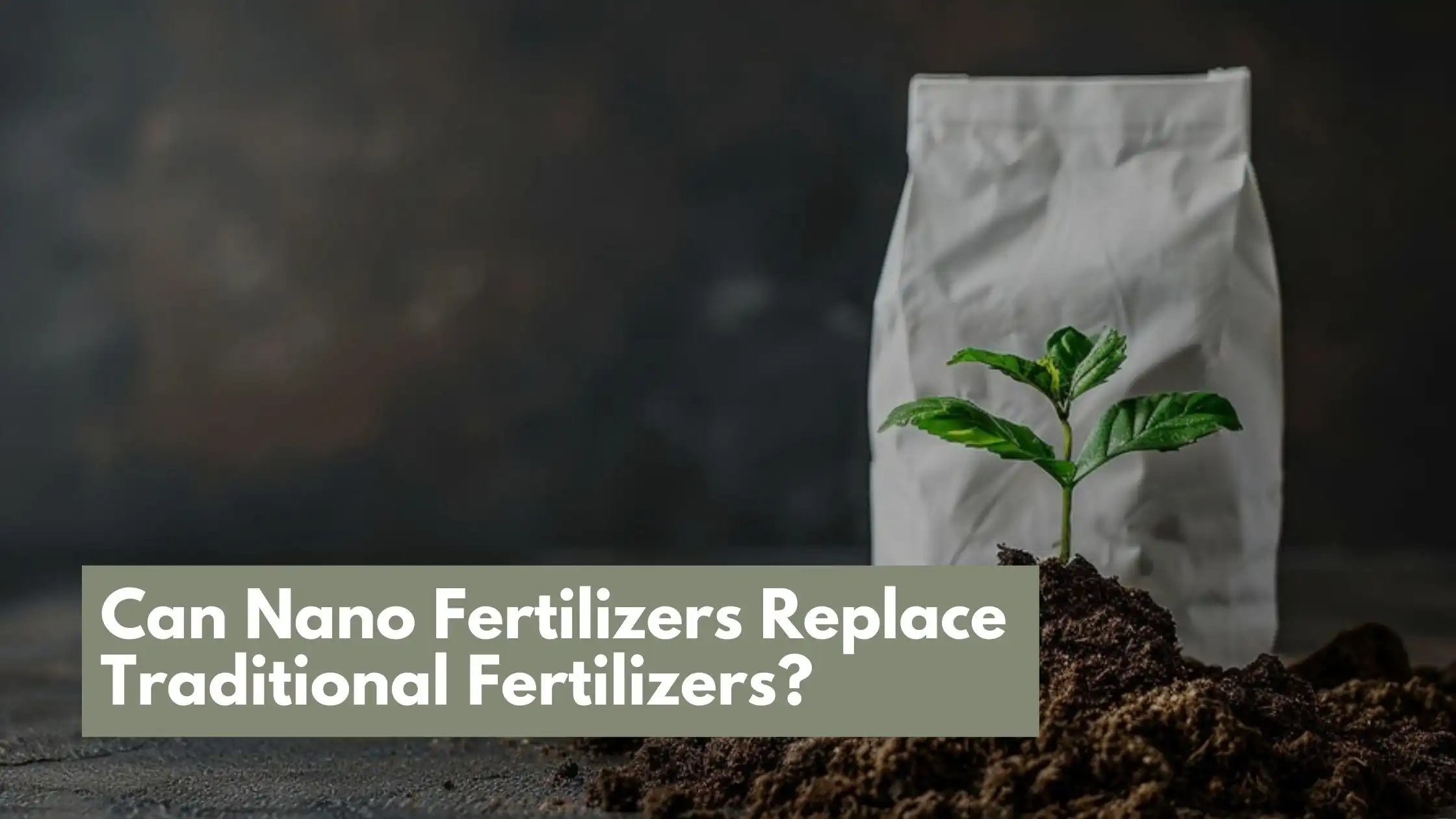What are Nano Fertilizers?
Nano fertilizers are a type of fertilizers that incorporate nanotechnology to enhance nutrient delivery and efficiency in agriculture. Nanoscale particles or structures compose them, and experts specifically design them to improve the effectiveness of nutrient application to plants.
Nano fertilizers have two main categories: nano-based nutrient carriers and nano-enhanced conventional fertilizers.
Nano-based nutrient carriers:
These nano fertilizers utilize nanoscale particles or structures to encapsulate or modify nutrient compounds. Various materials, including nanoparticles, nanocapsules, nanotubes, or nanocomposites, can constitute nanocarriers. These carriers load or attach the nutrients, protecting against leaching or volatilization and regulating their release into the soil or plant system. The controlled release feature allows for a gradual and sustained supply of nutrients, ensuring that plants receive nutrients when needed most.
Nano-enhanced conventional fertilizers:
In this approach, nanotechnology modifies traditional fertilizers by incorporating nanoscale additives. These additives can improve the fertilizers’ solubility, dispersibility, or reactivity, thereby enhancing their nutrient availability and uptake by plants. By reducing the size of the additives to the nanoscale, their surface area increases, leading to improved interaction with plant roots and increased nutrient absorption.
Objectives of Nano Fertilizers
The primary objectives of nano fertilizers are improving nutrient use efficiency, reducing nutrient losses, and enhancing crop productivity. By leveraging the unique properties of nanomaterials, such as their small size, high surface area, and surface reactivity, nanofertilizers offer several potential benefits in agriculture:
Increased nutrient uptake:
The nanoscale particles in nano fertilizers enable better interaction with plant roots, facilitating efficient nutrient absorption and uptake.
Controlled release:
Nano-based nutrient carriers allow for the controlled and gradual release of nutrients, ensuring a sustained supply to plants over an extended period.
Targeted delivery:
Nano fertilizers deliver nutrients directly to specific plant tissues or root zones, optimizing nutrient utilization and reducing wastage.
Improved nutrient availability:
Nanotechnology can enhance the solubility and accessibility of nutrients, overcoming limitations associated with low nutrient availability in the soil.
Reduced environmental impact:
Nano fertilizers can minimize nutrient runoff and leaching, reducing the risk of water pollution and environmental contamination.
It’s important to note that nano fertilizers are still an emerging technology, and further research is needed to fully understand their long-term effects, potential risks, and commercial viability. Regulatory frameworks and guidelines are developed to ensure their safe and responsible use in agriculture.
Nano fertilizers in agriculture
Applying nano fertilizers aims to improve nutrient utilization, reduce environmental impact, and enhance crop productivity.
Here are some key aspects and potential benefits of nano fertilizers in agriculture:
Controlled nutrient release:
Nano fertilizers release nutrients gradually, providing a sustained supply over an extended period. This controlled release minimizes nutrient losses through leaching or volatilization and ensures that plants receive the most nutrients they need.
Increased nutrient uptake:
The nanoscale particles in these fertilizers can enhance nutrient uptake by plants. Their small size and high surface area enable better interaction with plant roots, facilitating efficient absorption of nutrients. This improved uptake can lead to higher nutrient-use efficiency and reduced fertilizer wastage.
Targeted nutrient delivery:
Nano fertilizers target specific plant tissues or root zones, enabling precise delivery of nutrients where they are most needed. This targeted approach minimizes nutrient losses and ensures that plants receive optimal nutrition, even in challenging soil conditions.
Improved nutrient availability:
Nanotechnology can enhance the solubility and availability of poorly soluble or immobile nutrients. By converting nutrients into nanoscale forms, their accessibility to plants increases, thereby overcoming limitations associated with low nutrient availability in the soil.
Reduced environmental impact:
Nano fertilizers offer the potential to reduce environmental pollution associated with conventional fertilizers. Their controlled release and improved nutrient uptake minimize nutrient runoff into water bodies, which can contribute to water pollution and eutrophication. Additionally, their enhanced nutrient-use efficiency reduces the need for excessive fertilizer application, lowering the risk of environmental contamination.
Enhanced crop productivity:
The targeted and efficient delivery of nutrients through nano fertilizers can improve crop yields and quality. By optimizing nutrient availability, uptake, and utilization, these fertilizers have the potential to enhance plant growth, root development, flowering, and fruiting, thereby increasing agricultural productivity.
However, it’s important to note that nano fertilizers are still in the early stages of development, and there are limitations in their widespread adoption. Further research must address concerns about their long-term environmental impact, potential toxicity, and cost-effectiveness compared to traditional fertilizers. Regulatory frameworks and guidelines are also made to ensure the safe and responsible use of nano fertilizers in agriculture.
What are traditional fertilizers?

Traditional fertilizers refer to the conventional types of fertilizers that have been used in agriculture for many years. These fertilizers are typically composed of macro and micronutrients in their elemental or compound forms, designed to supply essential nutrients to plants for optimal growth and development.
Traditional fertilizers are typically available in solid forms like granules, powders, or pellets, applied to the soil or plants. Conventional farmers use them based on soil nutrient analysis, crop nutrient requirements, and recommended application rates.
It’s important to note that while traditional fertilizers have been widely used in agriculture, their usage should be carefully managed to prevent excessive application, nutrient runoff, and environmental pollution. Sustainable fertilizer practices, such as precision application techniques, soil testing, and nutrient management plans, should followed to optimize their effectiveness and minimize potential negative impacts.
Nano Fertilizers vs traditional fertilizers
Nano fertilizers and traditional fertilizers are two distinct types used in agriculture, and they differ in several key aspects. Here’s a comparison between the two:
Composition:
Traditional fertilizers consist of macro and micronutrients in either elemental or compound forms. These nutrients are typically derived from natural sources or synthesized chemically. Nano fertilizers, conversely, incorporate nanoscale particles or structures that encapsulate or modify nutrient compounds. These particles may comprise various materials, including nanoparticles, nanocapsules, or nanocomposites.
Nutrient delivery:
Traditional fertilizers are applied to the soil or plants in their original form. Once used, the nutrients become available for plant uptake through dissolution or mineralization. Fertilizers often utilize controlled-release mechanisms. Nanoscale particles or structures in fertilizers provide controlled and gradual nutrient release, ensuring a sustained supply of nutrients to plants over an extended period.
Nutrient uptake and efficiency:
Nano fertilizers have the potential to improve nutrient uptake and utilization by plants. These fertilizers’ nanoscale particles or structures offer a higher surface area, facilitating better interaction with plant roots and enhancing nutrient absorption. This improved uptake can result in increased nutrient-use efficiency and reduced fertilizer wastage. Traditional fertilizers, while effective, may have lower nutrient-use efficiency due to losses through leaching or volatilization.
Environmental impact:
Nano fertilizers have the potential to reduce environmental pollution compared to traditional fertilizers. The controlled-release mechanisms of fertilizers can minimize nutrient runoff and leaching, reducing the risk of water pollution and environmental contamination. If not applied correctly or excessively, traditional fertilizers can contribute to nutrient runoff, adversely affecting water bodies and ecosystems.
Cost-effectiveness:
Traditional fertilizers are typically more readily available and cost-effective compared to fertilizers. Nano fertilizers may involve additional production costs due to the nanomaterials and complex manufacturing processes. However, as nanotechnology advances and economies of scale are achieved, the cost of fertilizers may become more competitive.
Research and adoption:
Traditional fertilizers have a long history of research, development, and widespread adoption in agriculture. They are well-established and have proven their efficacy in improving crop productivity. Fertilizers, on the other hand, are relatively new and still undergoing research and development. While promising, their adoption in agriculture is limited, and further studies are needed to fully understand their long-term effects, potential risks, and practicality.
In summary, fertilizers and traditional fertilizers differ in composition, nutrient delivery mechanisms, potential benefits, and environmental impact. The choice between them depends on various factors such as crop type, soil conditions, nutrient requirements, environmental considerations, and cost-effectiveness.
Can Nano Fertilizers replace traditional fertilizers?
While nano fertilizers offer several potential advantages in terms of nutrient delivery and efficiency, it is unlikely that they will completely replace traditional fertilizers. Here are a few reasons why:
Cost:
Nano fertilizers are currently more expensive to produce compared to traditional fertilizers. Incorporating nanotechnology into fertilizer production involves additional research, development, and manufacturing costs. This cost difference makes nano fertilizers less economically viable for large-scale agricultural use, particularly in regions where cost-effective traditional fertilizers are readily available.
Research and development:
Nano fertilizers are still in the early stages of research and development. While they have shown promise in laboratory and small-scale studies, their long-term effects on crop growth, soil health, and environmental impact still need to be fully understood. Further research is required to assess their efficacy, safety, and practicality in different agricultural systems and crops.
Practicality and scalability:
The production, application, and handling of nano fertilizers may pose challenges regarding scalability and practicality. The manufacturing processes for fertilizers can be complex and require specialized equipment and expertise. Additionally, the application methods and equipment needed for fertilizers may differ from those used for traditional fertilizers, which can impact their adoption by farmers on a large scale.
Nutrient requirements:
While nano fertilizers can improve nutrient uptake and utilization, they may only meet some of the nutrient requirements of plants. Traditional fertilizers contain a range of macro and micronutrients in specific compositions essential for plant growth and development. Fertilizers may be better suited to complement conventional fertilizers, rather than a complete replacement, to address specific nutrient deficiencies or enhance nutrient delivery in targeted applications.
Environmental considerations:
While nano fertilizers can potentially reduce nutrient losses and environmental pollution compared to traditional fertilizers, their long-term environmental impact is still being studied. It is crucial to thoroughly assess the potential risks associated with nanomaterials, such as their toxicity, ecological accumulation, and effects on non-target organisms, before widespread adoption can be considered.
In conclusion, while fertilizers offer exciting possibilities for improving nutrient delivery and efficiency in agriculture, they will only partially replace traditional fertilizers. Both fertilizers have advantages and limitations, and the choice between them will depend on factors such as cost, practicality, crop requirements, and environmental considerations. The future of fertilizers lies in their integration with traditional fertilizers and the development of targeted and sustainable nutrient management strategies.
Conclusion
In conclusion, nano fertilizers represent an emerging field of research and development in agriculture. They utilize nanotechnology to enhance nutrient delivery and efficiency, potentially improving crop productivity, reducing environmental impact, and optimizing nutrient utilization. Nano fertilizers offer controlled-release mechanisms, increased nutrient uptake, targeted delivery, and enhanced nutrient availability.
The future of nano fertilizers lies in their integration with traditional fertilizers and the development of targeted and sustainable nutrient management strategies. Combining the strengths of both fertilizers and conventional fertilizers makes it possible to optimize nutrient delivery and achieve efficient and sustainable agricultural practices.
It is crucial to continue studying and evaluating nano fertilizers’ potential benefits, limitations, and environmental implications to ensure their responsible and effective use in agriculture.




Your point of view caught my eye and was very interesting. Thanks.
Thanks for sharing. I read many of your blog posts, cool, your blog is very good.